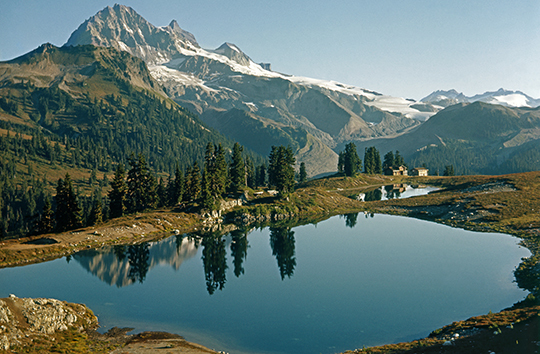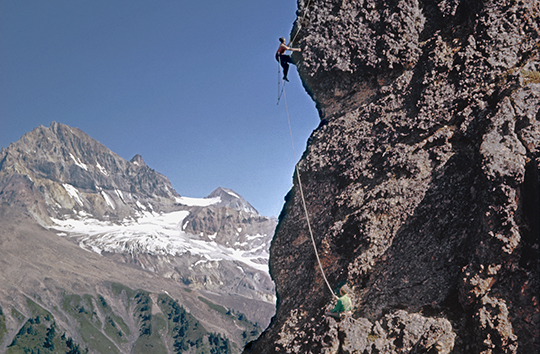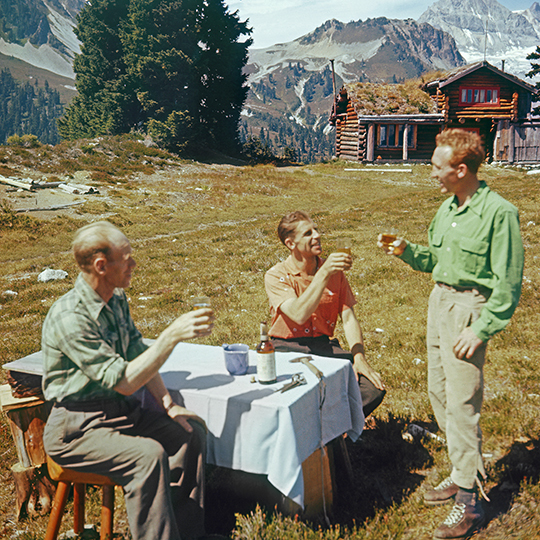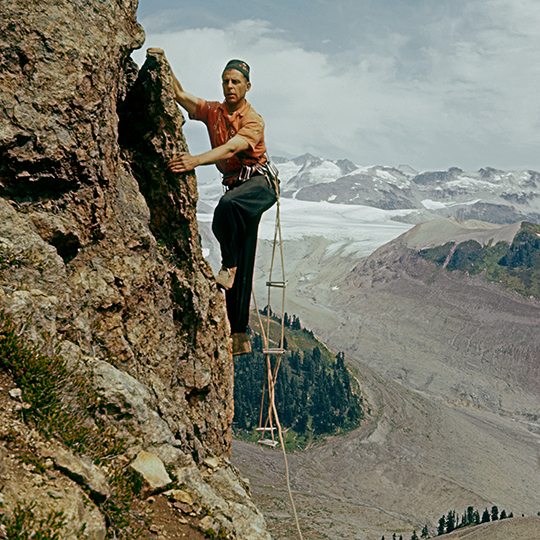
In the Alpinist 43 Crag Profile of Squamish, British Columbia, Tami Knight writes:
“Nostalgia comes easily to climbers, who are apt to recall their youthful adventures as a period when soft, yellowed light infused the air and angels sang…. Generations have been bound together…[in Squamish] by a long suffering of rain, a love of beer or bongloads and a deeply rooted attachment to that powerful spirit derived from this place.”
The late 1950s and early 1960s marked the arrival of Highway 99 in that small logging town, and a shift in climbers’ interest from peaks with pointy summits to rock faces with technical challenges. In this Web feature, Ed Cooper and Dick Culbert reflect on those early days leading up to the first ascent of the Grand Wall in 1961. –Ed.
Culbert:
Much of my early attention in Squamish focused on a group of rotten volcanic pinnacles that we called the Touch and Go Towers, because everything that you touched “went.” All but forgotten, they still stand above the mouth of the Squamish River. There was a swinging bridge across the lower Squamish River in those days that also gave access to the southern Tantalus Range. I continue to be surprised that the bridge has not been replaced despite the fevered development of the area.
Although I was certainly there in the early days, I was never a major fan of the Chief, and used it mainly as something to do in winter and spring when the mountains were under snow. Hence my early recollections are of greasy slabs and mossy cracks in mountain boots or running shoes.
Around 1955, at age 15, I was a timber cruiser’s summer assistant, and I scrambled up the backside of the Chief where the trail is being turned into a stair-climbing exercise today. The only trails then were related to an active logging operation. In fact, the road arrival at Squamish found a sleeping town based on logging and the railway. (Even in the 1960’s it was easier to jump a freight train in Squamish for points north, than from North Vancouver rail yard.) My memories of early bivouacs on the Chief were of looking down on a dark and quiet town. There would be yelling and fights around the time the pubs closed, lots of barking dogs and roosters at dawn.
The mountaineers in Vancouver who were interested in the challenging stuff were a small band indeed, and when confronted with the Chief in 1958, we were a bit perplexed. As self declared “climbers” we felt we should do something with it, but then, “Look for yourself, there are no holds on the damn thing, and any crack you could get your fingers into is full of dirt and bushes.” There was also an early reluctance to think of rock climbs that did not lead to a real peak as more than “practice climbs.”

Cooper:
The first time I saw the Chief was in 1958, when I accompanied Fred Beckey, Les MacDonald and Ira Spring on a professional photo shoot near Garibaldi Meadows for a Canadian Club Whiskey ad. Ira Spring, a well-known Seattle photographer specializing in mountain photography, was the photographer of choice. I was merely a “hanger-on” to give climbing support, if any was needed, to the main climbers. It just happened that I brought along my not-very-sophisticated, medium-format camera and also took pictures, albeit not very sharp ones. (Fortunately, those pictures have survived, despite my many moves in my early years.)
At that time, Fred referred to the Chief as “Goose Rock,” a very inelegant name for such a great formation. I have no idea how this nomenclature originated. I do remember looking at it, and wondering how anyone could climb the face of that rock. The details of the first climb of the Grand Wall have been written about elsewhere [That includes the Issue 43 Crag Profile of Squamish.–Ed.], but I would like to add some comments about it.
In 1960 I met Jim Baldwin climbing at Castle Rock near Leavenworth in Washington, still a very popular rock climbing area. At the time, he was a student at University of British Columbia (UBC). We talked about climbing a direct route on the face of the Chief and decided to have a look in the fall of 1960. In the process of making some other climbs on smaller cliffs (most first ascents), we had a chance to study the Chief, and picked out a route that led up to a pillar with a long crack on the right side.

The following May, we returned, and as our first order of business, we cut a trail through the rain forest, using saws and clippers, to the base of the face that is most prominently seen from the highway. Jim Sinclair, now a historian of all things about the Chief, helped us. This is the face now known as the “Grand Wall,” a term coined by Jim Baldwin early on. This is the trail that is still used today.
Culbert:
Although there were purists in those bygone days that considered people who used pitons and bolts as mere “hardware merchants,” the real problem was that the quality and availability of the things in the late Fifties did not give them all that much advantage. I was with Jim Baldwin on a tower in Tumwater Canyon when we drove our first piton–it promptly pulled out when we put weight on it. Much of the early piton driving on the Chief was because you could get one to go into a dirt-filled crack, where fingers were blocked. I am perfectly happy to see cracks cleaned out, although some of the gnarled little trees clinging to the face had real character.

Cooper:
One question that has been asked of me recently is whether the tree growing at the base of the Split Pillar should be removed, or whether, in general, vegetation on the Chief should or should not be removed from climbing routes. I don’t have a really good answer to this question. When we climbed the Grand Wall, the tree at the base of the Split Pillar was only a small shrub. That the Split Pillar will eventually fall I have no doubt. When we climbed it using the bombproof pitons made by the local blacksmith (which weighed in at almost a pound apiece and could probably have held a large truck), these pitons actually moved the Split Pillar a fraction of an inch or more. This I know because, after placing a number of them in the large crack in the Split Pillar, I looked down to find that all of the lower “bombproof” pitons had fallen out. It was at this point I placed a bolt in the wall besides the crack in the Split Pillar for protection in such an event.
In those early days, the most amazing thing to us was that there were very few climbers visiting the Chief, and all of them were climbing on the periphery of the really steep walls. We speculated at that time, and in fact were sure of it, that it was only a matter of time before large numbers of climbers would be attracted to climb the walls of this large granite formation. It was a natural with such a large population center only an hour’s drive away. And of course, the passage of time has proven our early speculations correct, to the “nth” degree.
